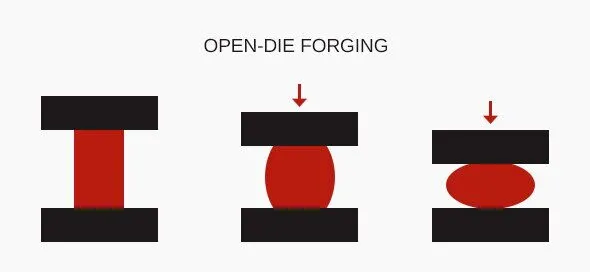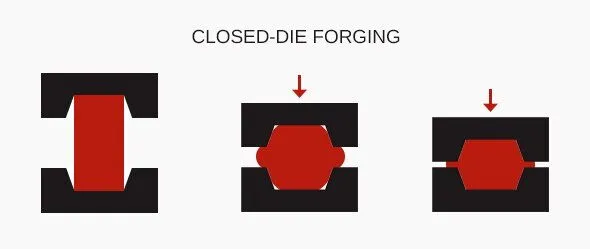Forging is a manufacturing process in which metal materials undergo plastic deformation through the application of external force. The primary goal is to alter the shape, structure, and properties of the metal. Depending on the processing method and technique, forging can be classified into two main types: open die forging (also known as free forging) and closed die forging. Although both processes fall under the umbrella of forging, there are significant differences between them in terms of operation, applicable scope, production efficiency, cost, and product quality. This article will provide a detailed comparison of the two forging methods, exploring their technological characteristics, advantages, disadvantages, and areas of application, to help you better understand the features of both methods and the factors to consider when choosing between them.
Open die forging refers to a forging process in which metal billets are deformed by applying external force using equipment such as hammers and hydraulic presses, without the need for specialized molds. In this process, the metal billet is subjected to repeated operations such as upsetting, stretching, and shifting to achieve the desired shape and size. Open die forging is highly flexible and adaptable, making it suitable for processing a wide range of materials and shapes. As a result, it is widely used for small batch production, customized manufacturing, and the production of simple-shaped forged parts.
The primary characteristic of open die forging is its use of simple tools and the absence of specialized molds. Typically, equipment such as hammers and hydraulic presses are employed, which can apply force in different directions and offer a high degree of adaptability. Through gradual changes to the billet's shape, internal stresses are reduced, and material wastage is minimized, leading to improved internal quality.

The typical process flow for open die forging includes several key steps:
Upsetting and Stretching: Initially, the billet is upset to form a rough shape. The stretching operation further changes the billet's length or shape, preparing it for subsequent processes.
Punching and Cutting: Punching or cutting is performed to remove excess material, ensuring the forged part meets the required size and precision.
Bending and Shifting: These operations adjust the billet's shape, particularly for complex parts, where bending and shifting are often necessary to ensure the final forged part meets design specifications.
Finishing Operations: This includes deburring, removing excess material, and correcting the shape. These steps ensure that the final forged part has a smooth surface and meets quality standards.
Open die forging offers several advantages, particularly in terms of flexibility and adaptability, as well as its simplicity in equipment requirements and production process. Some of its main benefits are as follows:
High Flexibility: Open die forging is highly adaptable, capable of producing parts with simple to complex shapes. Since it does not rely on specialized molds, it can quickly adjust to different production requirements.
Versatility in Production Needs: The simple equipment and tools used in open die forging allow it to process a wide range of materials, making it ideal for small batch and diverse production. It is especially advantageous in customized production or prototype development.
Higher Material Utilization: The process of gradually forming the billet reduces material wastage, thereby improving the overall material utilization.
Better Internal Quality: Open die forging improves the flowability of the metal, eliminating defects such as porosity and inclusions, which enhances the internal quality of the forged part.
While open die forging has notable advantages, it also has some limitations that must be considered:
Lower Production Efficiency: Each step in the open die forging process requires manual operation, making it slower compared to closed die forging. In high-volume production, open die forging may not meet the efficiency requirements.
Lower Dimensional Precision: The dimensional accuracy of open die forged parts is typically lower, requiring additional post-processing to refine the shape or adjust the dimensions.
Dependence on Worker Skill: The quality and efficiency of open die forging are heavily influenced by the operator's skill and experience, which can vary.
Closed die forging involves the use of specialized molds and forging equipment to shape metal billets inside the die. In this process, the metal is deformed by applying pressure within the mold, causing it to take on the desired shape. Compared to open die forging, closed die forging uses closed molds, which help achieve more uniform metal flow, resulting in higher precision and better surface quality.
Closed die forging is well-suited for mass production of high-precision, complex parts, and is commonly used in industries such as aerospace, automotive, energy, and machinery manufacturing. Due to its advantages in precision and efficiency, many high-demand components, particularly those requiring large-scale production, are manufactured using this process.

The process flow for closed die forging differs from open die forging and includes the following main steps:
Preheating the Billet: The metal billet is typically preheated to the appropriate temperature to facilitate plastic deformation.
Die Design and Selection: A suitable die is chosen based on the desired shape and size of the forged part. The die design must account for factors such as metal flow, temperature, and pressure.
Forging and Shaping: The preheated billet is placed into the die, where pressure is applied to shape it and fill the die cavity.
Finishing Operations: Similar to open die forging, closed die forging also requires finishing steps such as deburring, surface cleaning, and shape correction.
Closed die forging offers several significant advantages, particularly for large-scale production of complex, high-precision parts:
High Precision: Closed die forging provides better dimensional accuracy and surface finish, making it ideal for producing parts with high precision.
High Production Efficiency: The process is well-suited for mass production, allowing large quantities of parts to be produced quickly. Since specialized molds are used, material waste is minimized, and production is more efficient.
Ability to Process Complex Shapes: Closed die forging is capable of efficiently producing parts with complex geometries, distributing metal evenly across the die to ensure high-quality, strong forged parts.
Reduced Post-Processing Needs: Forged parts produced through closed die forging usually have smooth surfaces and high dimensional accuracy, minimizing the need for additional processing.
While closed die forging is advantageous in many ways, it does come with certain drawbacks:
High Equipment and Tooling Costs: Closed die forging requires specialized dies and high-performance forging equipment, which come with significant investment and maintenance costs.
Limited Flexibility: Once the die is made, it is not as adaptable as open die forging, making it less suitable for small batch production or frequent design changes.
Longer Tooling Lead Time: The design and manufacturing of dies for closed die forging can take considerable time, particularly for complex parts.
Open die forging and closed die forging are two common forging methods, each with distinct features, advantages, disadvantages, and applications. In actual production, selecting the appropriate forging method is crucial based on factors such as part requirements, production volume, complexity, and cost. The following is a comparison of the two methods from several aspects.
Open die forging generally has lower production efficiency due to the need for manual operations, and each part takes longer to complete. In contrast, closed die forging is more efficient, particularly in high-volume production, as it utilizes specialized molds and automated equipment.
Closed die forging yields parts with higher precision and better surface quality, meeting stringent production standards. Open die forging, on the other hand, typically requires more post-processing to achieve the desired dimensions and finish.
Open die forging is suitable for small batch, multi-variety, and simple-shaped parts. It is especially beneficial for custom or specialty material production. Closed die forging is more suitable for mass production of standardized parts, particularly in industries such as automotive, aerospace, and military, where high precision is required.
Open die forging requires lower equipment and tool investments, making it suitable for small-scale production with a higher cost-performance ratio. Closed die forging, on the other hand, requires significant initial investment in equipment and dies, making it more appropriate for large-scale production with lower unit costs.
Both open die forging and closed die forging have their respective advantages and limitations. In practice, the choice between the two methods depends on factors such as production volume, part complexity, equipment investment, and cost. Open die forging is more suitable for small batch production and simple parts, offering greater flexibility. On the other hand, closed die forging excels in production efficiency, part quality, and precision, making it ideal for large-scale manufacturing. As automation technology continues to evolve, the combination of both methods may further enhance production efficiency and part quality, enabling them to serve a broader range of applications.